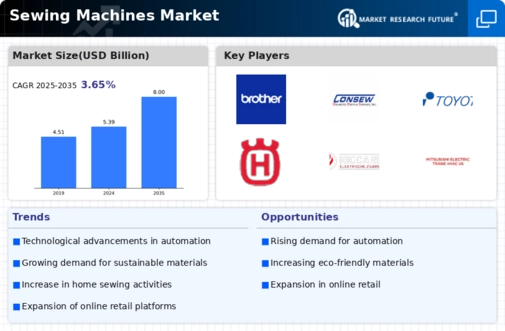Top Industry Leaders in the Sewing Machines Market

The sewing machines market, an integral part of the textile and garment industry, has undergone significant developments as consumers continue to engage in DIY sewing projects and home-based clothing manufacturing. As of 2023, key players in this market have strategically positioned themselves to address the growing demand for sewing machines, offering a diverse range of models catering to various skill levels and preferences.
Key Players:
- Aisin Seiki Co., Ltd. (Japan)
- Merrow Inc. (US)
- Jack Sewing Machine Co., Ltd. (China)
- Pegasus Sewing Machine Mfg. Co., Ltd. (Japan)
- Usha International Limited (India)
- SEIKO Sewing Machine Co., Ltd. (Japan)
- SVP Holdings Ltd. (US)
- Brother International Corporation (US)
- Bernina International AG (Switzerland)
- Rimoldi& CF srl (Italy)
- China Feiyue USA Inc. (US)
- Kaulin Manufacturing Co., Ltd. (Taiwan)
- Janome Sewing Machine Co., Ltd. (Japan)
- Tacony Corporation (US)
- Juki Corporation (Japan)
Strategies Adopted:
The sewing machines market employ various strategies to maintain and enhance their market positions. Product diversification is a common approach, with brands offering a variety of sewing machine models, including mechanical, computerized, and embroidery machines, to cater to different user needs. Marketing strategies include partnerships with fashion influencers, showcasing the versatility and capabilities of their machines, and educational campaigns to empower consumers with sewing skills. Pricing strategies vary, with some brands positioning themselves as budget-friendly options for entry-level sewers, while others focus on premium offerings with advanced features. Distribution strategies encompass both traditional retail channels and e-commerce platforms, ensuring accessibility to a broad consumer base. Additionally, brands emphasize continuous innovation, introducing new features such as touchscreen interfaces, automatic threading, and connectivity options to stay ahead in the competitive landscape.
Market Share Analysis:
The sewing machines industry involves evaluating several factors. Brand reputation and customer trust play a crucial role, with consumers often choosing well-established and reliable brands for their sewing machine purchases. The ability to offer a comprehensive range of machines suitable for various sewing applications, including garment construction, quilting, and embroidery, contributes to market share growth. Pricing competitiveness, promotional activities, and product availability across multiple sales channels impact market share dynamics. Quality of construction, durability, and ease of use influence consumer satisfaction and brand loyalty. Positive customer reviews, ratings, and endorsements from sewing communities also play a role in shaping brand perception and influencing market share within the highly competitive landscape.
News & Emerging Companies:
The sewing machines market has seen the emergence of new companies focusing on innovative designs, compact models for portability, and smart sewing technologies. Emerging companies often leverage digital marketing, e-commerce platforms, and collaborations with sewing influencers to establish their presence in the competitive market. News in this industry typically revolves around new entrants introducing unique sewing machine features, efforts to make sewing more accessible through user-friendly designs, and investments in research and development for novel sewing technologies.
Industry Trends:
The sewing machines market often highlights trends in smart technologies, sustainability, and advancements in user interfaces. Companies are increasingly investing in technology, exploring the integration of smart features into sewing machines, such as mobile app connectivity, guided tutorials, and automatic stitch recommendations. Current investment trends reveal a focus on sustainability, with brands adopting eco-friendly manufacturing practices, exploring recyclable materials, and implementing energy-efficient production processes. Additionally, investments in research and development aim to create sewing machines with innovative features, such as improved stitch precision, customizable embroidery options, and enhanced durability, addressing evolving consumer preferences for advanced and sustainable sewing solutions.
Competitive Scenario:
The sewing machines market is characterized by a mix of established brands with a rich heritage and emerging players focusing on innovation and technology. Established brands leverage their decades-long experience, global marketing reach, and commitment to quality to provide consumers with a diverse selection of sewing machines. Emerging brands, on the other hand, focus on agility, unique designs, and technological advancements to differentiate themselves in the competitive landscape.
The role of e-commerce has significantly impacted the competitive landscape, allowing both established and emerging brands to reach consumers directly, provide detailed product information, and offer online tutorials and support. Brands that effectively utilize digital marketing, optimize the online shopping experience, and engage with consumers through educational content on sewing techniques are better positioned to succeed in the evolving market.
Recent Development
The sewing machines market witnessed a notable development as Brother Industries, Ltd. introduced a new computerized sewing machine with enhanced artificial intelligence (AI) capabilities. The innovation aimed to provide users with advanced stitch recommendations based on the fabric type, sewing project, and user preferences. The integration of AI technology represented a significant leap in the sewing machines market, enhancing the user experience and simplifying complex sewing tasks. Brother's investment in this technology showcased the company's commitment to staying at the forefront of innovation and addressing the evolving needs of both novice and experienced sewers. The introduction of the AI-enabled sewing machine demonstrated the industry's dedication to embracing smart technologies for a more intuitive and efficient sewing process.


